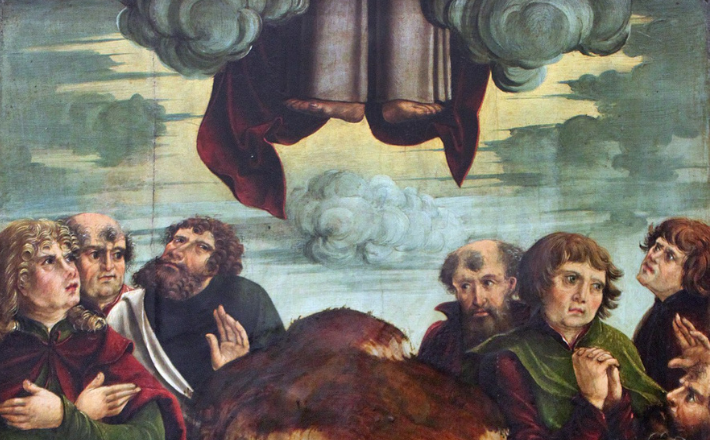Commentary on Luke 24:44-53
The Ascension is not an easy day to preach. Luke is the only gospel that gives us an actual picture of the moment—and then he gives us differing accounts! Luke 24 describes the scene differently than Acts 1:1–11, most notably changing the event’s timing.
In today’s reading, the ascension appears to take place on the evening of Easter itself, whereas in Acts, 40 days have passed. When the scriptures provide two versions of the same story, there are often different theological insights brought into focus by each. They function differently in the narratives in which they are embedded, and they focus the reader’s attention on distinct details and questions.1 Given its proximity to the events of Easter morning, the version of the ascension in Luke 24 highlights the relationship between the ascension and Jesus’ resurrection. Jesus’ person is centered in the narrative. Acts 1 highlights the relationship between the ascension, the nature and work of the church, and the promise of the Holy Spirit.
These topics are, of course, related in Luke-Acts. The work of the Spirit has been intimately connected with Jesus’ embodied presence from the start of Luke’s gospel (in other words, 1:35, 41; 2:26; 3:22), so it is no surprise that these passages share significant similarities: Both call the disciples to wait in the city until “clothed with power from on high” (Luke 24:49; Acts 1:4–5).2 both describe a proclamatory mission to all nations, beginning in Jerusalem (Luke 24:47; Acts 1:8). And critically, both use the word “witnesses” to describe the disciples’ identities (Luke 24:48; Acts 1:8).3 But if the emphasis in Acts is on the horizon and the significant changes that are coming to this small band of believers, the emphasis in Luke is on the continuity of God’s faithfulness and the continuity in Jesus’ person prior to and after the resurrection.
The inclusion of verses 44–45 in today’s reading speaks to the trustworthy character of God in Christ. Much has changed for the disciples on this Easter day, but the words that Jesus speaks on this monumental evening resonate with what he spoke to them prior—and significantly, these words also stand in continuity with “the law of Moses, the prophets, and the psalms” (verse 44). The new creation of Easter does not negate God’s original creative, covenantal work. Luke uses the word “fulfill” to get at this continuity (verse 44). This has significance, of course, for how Christians today understand their relationship to the promises God makes to Israel.
But the continuity between what Jesus says now and what Jesus said before also has christological significance. Just prior to this passage, Jesus eats a piece of fish to show that he is no ghost. For all the differences between his pre- and post-resurrection body, Luke insists that the resurrection is more than a visionary projection. The resurrection has enfleshed weight. There are moments when Luke highlights the distinctiveness of Jesus’ resurrected body (his disappearance in Emmaus springs to mind; Luke 24:31), but as the text moves toward the ascension, Luke highlights the continuities between Jesus’ body now and Jesus’ body before Easter morning.4 It is as if Luke wants to make sure readers do not mistake the ascension for a trick of the light. More significantly, Luke wants to ensure that readers do not interpret the resurrection as smoke and mirrors.
In Luke 24, Jesus’ physical, resurrected body is “carried up into heaven” (verse 51). There are all sorts of implications of this act for theologies of redemption and eschatological hope. But I want to focus on just one opportunity that preachers might take advantage of on this day. The ascension affirms God’s embrace of created life—human and nonhuman alike.
In contrast to theological readings of the ascension that emphasize Jesus’ escape from a fallen world, theologians like Elizabeth Johnson and Hannah Malcolm have emphasized creation’s exaltation.5 Scientists are becoming increasingly aware of the interconnectedness of enfleshed life. For Jesus to become a body—in other words, to breathe and eat and be born through a birth canal—microbes, bacteria, and even DNA from all manner of creatures would have had to have been held in his flesh. This is what being “flesh” entails. When Jesus ascends to heaven, all of this creaturely life is welcomed into the throne-room of God. The ascension is anything but a creation-denying doctrine. Luke’s emphasis on Christ’s enfleshed body being lifted to God is a profound affirmation of heaven’s redemptive embrace of the entire cosmos.
The last vision of Jesus in the Gospel of Luke shows him with arms outstretched in blessing. This Sunday, preachers have an opportunity to speak the blessing of the ascension over a groaning planet.
Notes
- My thanks to Dr. Colin Yuckman for his insights about how Luke’s two versions of the ascension remind him of the diverse theological functions that the creation accounts in Genesis 1 and Genesis 2–3 play (personal conversation, January 14, 2025).
- Acts 1 uses the language of the “Holy Spirit” explicitly, (verse 8).
- The Greek word for “witness” is the same as the word for “martyr,” suggesting the costly, embodied commitment this proclamation will require.
- Brittany Wilson, The Embodied God: Seeing the Divine in Luke-Acts and the Early Church (Oxford: 2021), 260.
- Elizabeth Johnson, Creation and the Cross: The Mercy of God for a Planet in Peril (Orbis, 2018); Hannah Malcolm, “Body Without End: Biological Mutualism and the Body of Christ,” International Journal of Systematic Theology 25, no. 2 (April 2023): 312–328.



May 29, 2025